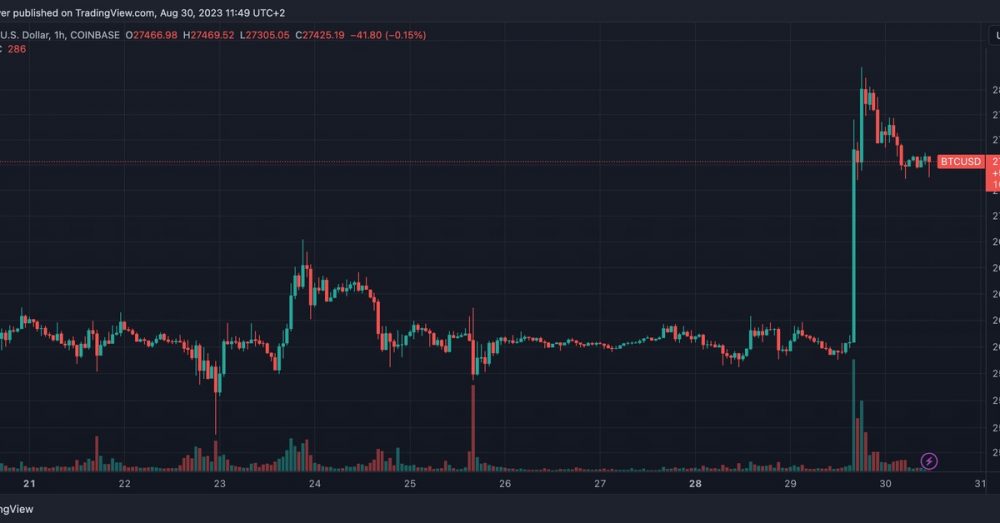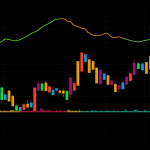Since late 2021, the crypto market has been starved of a positive double whammy or days when both crypto-specific and macroeconomic developments align with the bulls.
The past 24-hours have been one of those rare periods, thanks to crypto asset manager Grayscale’s legal victory against a regulator and disappointing U.S. labor market data.
Grayscale and CoinDesk and both owned by Digital Currency Group (DCG).
A U.S. court on Tuesday asked the U.S. Securities and Exchange Commission (SEC) to review its rejection of Grayscale’s attempt to convert its trust into an exchange-traded fund (ETF).
Bitcoin rose over 6% to $28,000 following the court ruling, which raised hopes for an eventual launch of a spot-based ETF. Several experts say a spot-based ETF will likely open floodgates for mainstream money. Traditional finance giants like Blackrock have filed for a spot-based ETF.
“This Blackrock iShares ‘commodity’ Bitcoin ETF will attract an allocation of $20-50bn over time, a calculated assumption given that Gold ETFs alone hold $100 billion,” Markus Thielen, head of research and strategy at Matrixport, said in a note to clients on Wednesday. “The optimized, well-diversified (tactical) portfolio would allocate 21% to global equities, 42% to global fixed income (bonds, credit, loans, etc.), and 37% to alternatives — including 10.6% to Bitcoin.”
The crypto market also received good news from the U.S. Labor Department’s Job Openings and Labor Turnover Survey (JOLTS) survey, which showed vacancies dropped to the lowest level in over two years in July.
The data dented the appeal of the U.S. as a relatively strong economy, weakening the case for a continued Federal Reserve (Fed) rate hikes and sent Treasury yields and the dollar lower. The dollar index fell by nearly 0.5% on Tuesday.
“Recent data is eroding the narrative of U.S. resilience that had supported the rise of 10Y yields to above 4.3% over the past weeks. Poor job openings data and dipping consumer confidence yesterday saw the 10y falling through 4.2% and then briefly further towards 4.1% overnight,” analysts at ING said in a note on Thursday.
The U.S. resiliency narrative and the resulting uptick in yields and the dollar index were among the key factors that catalyzed bitcoin’s mid-August decline.
While the degree to which the JOLTS report contributed to bitcoin’s rise on Tuesday is not known, the report has created a risk asset-supportive environment for now. Bitcoin’s rise could have been more measured had the data bettered estimates.
“Yesterday was a typical ‘bad news is good news’ day. Risk sentiment in the U.S. and across the globe was boosted by an unexpected dip in U.S. job openings to below 9 million jobs in July, the lowest levels since more than two years, and an unexpected fall in consumer confidence in August,” Ipek Ozkardeskaya, senior analyst at Swissquote, said. “The weak data pushed the Federal Reserve (Fed) hawks to the sidelines, and bolstered the expectation of a pause in September, and tilted the probabilities in favor of a no hike in November, as well.”
Caution still warranted
Caution might still be warranted on the part of the bulls as Grayscale’s victory does not necessarily mean a spot-ETF launch is a done deal.
The SEC could come up with new reasons to reject Grayscale’s bid to cover its trust into an ETF or request an en banc appeal. Later this week, the agency is expected to delay its decision on spot bitcoin ETF applications of Bitwise, BlackRock, VanEck, Fidelity, Invesco and Wisdomtree. Further, a new secret court filing related to leading digital assets exchange Binance has markets worried about more bad news.
Regarding broader market sentiment, risk-off may return if U.S. data continues to disappoint, stoking recession fears. The U.S. is the world’s largest economy. Hence, a stateside recession could affect the global economy and investor risk appetite.
Traders may want to keep a close eye on how the Treasury yield curve reacts to potential weak data. Historically, it has de-inverted while heading into recessions, marking major tops in the S&P 500.
The U.S. will release the ADP private sector employment report for July and the second quarter GDP later Wednesday and the monthly nonfarm payrolls on Friday.







